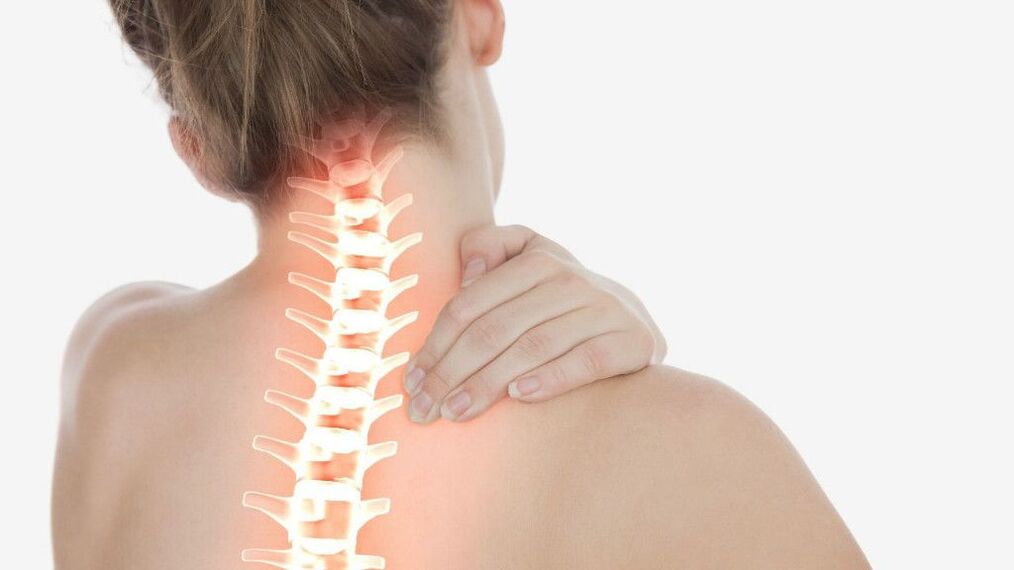Osteochondrosis of the cervical spine is a degenerative and dystrophic disease that affects the intervertebral discs of the neck.This pathology is the most common pathology of the spine.

Symptoms of the disease
As the disease progresses, characteristic symptoms appear.These include the following manifestations:
- Weakness
- Dizziness
- Headache
- Tinnitus
- Changing the function of the organ of vision (reduction of its weight, flickering flies in front of the eyes)
- Increased sensitivity in the arm
- Tingling of the arm
- Then a person can usually stop moving his hand
- Feeling of stiffness in the joints of the upper limb
- Neck
- Feeling of stiffness and chest pressure.
The causes of the disease
The main causal factors of osteochondrosis of the cervical spine are as follows:
- A little neck mobility leading to the fact that the intervertebral disc loses fluid, this also leads to a loss of cartilage elasticity
- Burdensome heredity that determines the reserve of the force of the intervertebral disc
- Microtraumasation of the cervical spine with sharp turns, tilting the head, etc.
- Metabolic disorders that negatively affect the condition of cartilage in the intervertebral disc.
Diagnostics
The diagnostic search for osteochondrosis of the cervical spine includes the following studies:
- X -ray
- Computed tomography
- Nuclear magnetic resonance
- Electromyography.
Each of the above studies carries certain diagnostic information.The first three allow you to identify the changes directly to the spine characteristic of osteochondrosis.The latest study allows you to diagnose the complications of osteochondrosis, which consist of damage to nerve trunks.
In different planes, X -ray examination is performed, and the sights are also carried out for a more accurate detail than characteristic changes.This study reveals the calculation in the ligamentary device of the spine, a change in the height of the intervertebral discs, the deformity of the cervical region, etc.
Computed tomography and nuclear magnetic resonance allow you to get the most reliable information, so it is recommended to use them in complex diagnostic cases.
Electromyography examines the conductivity in nerve fibers, which is very often with osteochondrosis of the cervical spine is reduced.This is due to the fact that with a decrease in the height of the intervertebral discs, the conditions for compression of the nerve roots are created.Therefore, such clinical symptoms such as increased sensitivity, paresis and paralysis occur.
Complications
The lack of timely treatment of osteochondrosis of the cervical spine can lead to the development of the following complications:
- Paralysis and paresis of the upper limb on one or two sides
- Ischemic stroke of the brain.
The treatment of the disease
The goals pursue the treatment of osteochondrosis are as follows:
- Reduce the severity of pain syndrome
- Preventing the progression of pathological changes.
The following methods are used to fulfill these purposes:
- Manual therapy is performed
- Acupuncture
- Medical physical education
- Gymnastics
- Swimming.
The goal is shown in parallel:
- Chondroproprotectors that increase cartilage resistance and allow it to recover
- Non -steroidal anti -inflammatory drugs that reduce the severity of pain.
Unique treatments
- Application kinesiology
It is a method for diagnosing and treating diseases of the spine, joints and nervous system based on muscle examination.The doctor with the help of hands studies the condition of the tissues and organs.
- Leeches
Along with a leech bite, about 100 biologically active components arrive in human blood.This helps to clean the blood vessels, eliminates blood clots and interferes with their formation.
- Reflexology
Acupuncture helps to cure osteochondrosis, radiculitis and other diseases of the spine and joints.The procedures relieve pain, heal the body and strengthen immunity.
Risk group
In the risk group, the following categories of people must include:
- Hereditary
- Jams
- Having background pathological processes.
Prevention
Preventive measures to prevent osteochondrosis of the spine are as follows:
- Proper stand while sitting
- Alternating loads and rest
- Exclusion Weight Weight (in this case it is better to give a backpack preference)
- Regular major medical examinations for a neurologist and an orthopedist for early detection of osteochondrosis of the cervical spine.
Diet and lifestyle
In the case of osteochondrosis, it is necessary to make certain adjustments to the lifestyle.They are as follows:
- Treatment of the background pathological process that led to osteochondrosis if found
- The exception of weighing
- Normalization of nutrition - rejection of fat, fried, acute, salty, increasing the content of vegetable fiber and products with chondroitin (jelly, jelly) in the diet
- Sufficient rate of physical activity.



















